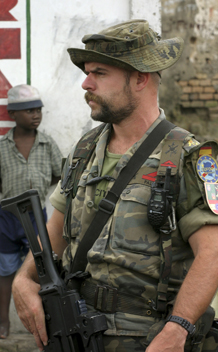Taking Conflict Prevention Seriously
More on:

Conflict prevention often seems like the weather. Everybody talks about it, but nobody does anything about it. Or so we believe.
In fact, over the past two decades the United Nations and a growing number of regional organizations have developed new capabilities to anticipate the outbreak of violence and stop it from bursting into conflagration. This growing attention to prevention is one of the most hopeful—and unsung—trends in world politics today.
As part of the opening of this year’s UN General Assembly, the Security Council met on Thursday in an extraordinary session to take stock of the UN’s capacities for preventive diplomacy—that is, its tools for heading off imminent violence, from coups to interethnic attacks to mass atrocities. The question of course, is whether this session will amount to anything more than lip service.
To be sure, a healthy dose of skepticism is in order. World leaders are fond of shibboleths about the wisdom of acting early but action rarely matches rhetoric. Consumed by the tyranny of the inbox, working level bureaucrats are notoriously poor at alerting their superiors, and their political masters are then wary of assuming concrete burdens to head off violence that may never come to pass. The value of conflict prevention is also notoriously difficult to prove. Success seems banal—since “nothing happens”—and attributing a peaceful outcome to a specific intervention requires proving a counterfactual: that all hell would have broken loose. Therefore, political will to act decisively is scarce until the bodies stack up like cordwood.
Given these structural disincentives, it comes as a surprise to learn that the world community has actually made tangible strides in building up its capacities for preventive action, at both the global and the regional level. And yet this is the hopeful message of a just-released CFR report by Paul Stares and Micah Zenko, Partners in Preventive Action: The United States and International Institutions. Against the odds, the United Nations and an alphabet soup of regional and subregional organizations are actually getting ahead of the conflict curve.
This is fortunate, for the demand is certainly there. Though both civil war and interstate conflict have declined since the mid-1990s, the rise of new global powers promises to incite more violent conflict. Similarly, declining resources, demographic pressures and climate change are ticking time bombs.
The authors make a compelling case that when it comes to conflict prevention, formal international institutions provide unique benefits that unilateral U.S action or ad hoc coalitions cannot generate. The United Nations and regional bodies play several indispensable roles: They
- help consolidate norms of conflict prevention, including the “responsibility to protect” (RtoP).
- offer a framework to legitimate collective diplomatic and military interventions, including those that might infringe on the bedrock principle of state sovereignty.
- provide platforms for marshalling and integrating the capabilities of multiple countries and for directing multinational operations.
- reduce the burden that might otherwise fall on the United States to lead the world in conflict prevention and peacemaking.
Partners in Preventive Action surveys the strengths and weaknesses of the principal international institutions.
The United Nations occupies pride of place in this evolving architecture. In recent years the UN’s Department of Political Affairs has established an impressive set of institutional “arrangements, deployable assets, and qualified personnel” for conflict prevention.
The most surprising progress, at least on paper, has been within the African Union, the successor organization to the Organization of African Unity (OAU). Shrugging off the OAU’s postcolonial insistence on absolute state sovereignty and neuralgia against intervention, the AU has now incorporated into its core documents a new principle of “non-indifference” to the internal political developments of its members. This includes an opposition to irregular transfers of power and the legitimation of intervention in situations of mass atrocities.
So far, so good. But the report also suggests the world community has a long way to go in turning its good intentions into sustainable conflict prevention. To begin with, the capabilities of regional (and subregional) organizations vary enormously. The European Union has incorporated conflict prevention as a core component of its Common Foreign and Security Policy, and has impressive diplomatic and military assets to deploy. By contrast, in the AU’s case there remains an enormous gap between the expectations generated by official policy documents and the body’s actual capacity to deliver.
Second, many regional organizations take most decisions on the basis of consensus such as the Organization for Security and Cooperation in Europe (OSCE), the Organization of American States (OAS), and the Association of Southeast Asian Nations (ASEAN). This has the potential to paralyze the organization, as the OSCE discovered following the Russian incursion into Georgia. In addition, some regional organizations—particularly ASEAN and the OAS—have a strong normative commitment to nonintervention, making them less than ideal partners in prevention.
Finally, the United Nations and regional organizations face the enduring conundrum of dividing limited resources between two goals. Crisis prevention and response, on the one hand, is imperative. Still, longer-term “structural prevention” can mitigate the risks and reduce the so-called “root causes” of violent conflict, through development and governance assistance, for example. Partners in Prevention suggests that these institutions cannot afford to choose, but instead must do it all. This is an admirable impulse, but it may not be a realistic strategy at a time of budgetary retrenchment, particularly among the wealthier members of the donor community.
More on:
 Online Store
Online Store